Nova Scotia
province, Canada
Introduction
Nova Scotia, flag of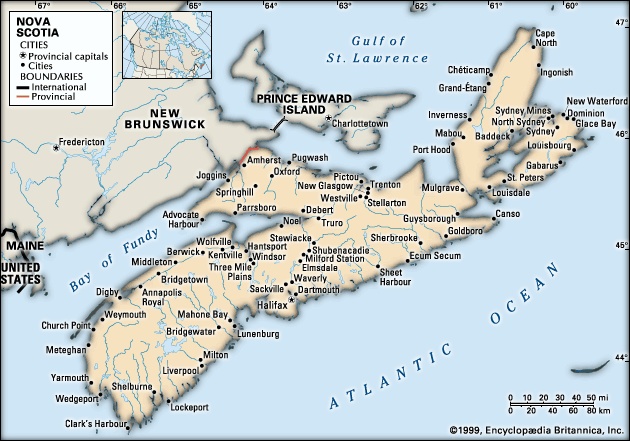
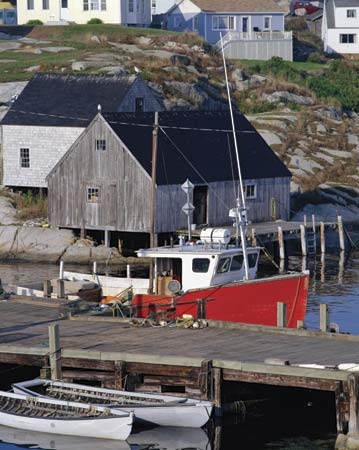 Canadian province located on the eastern seaboard of North America, one of the four original provinces (along with New Brunswick, Ontario, and Quebec) that constituted the Dominion of Canada in 1867. Roughly 360 miles (580 km) long but not more than about 80 miles (130 km) wide at any point, the province comprises the peninsula of Nova Scotia, Cape Breton Island (separated from the mainland to the southwest by the narrow Strait of Canso (Canso, Strait of)), and a number of small adjacent islands. Along the narrow Chignecto Isthmus, which seems to thrust the peninsula into the Atlantic Ocean, runs the province's only land boundary, with New Brunswick to the west. Two arms of the Gulf of St. Lawrence (Saint Lawrence, Gulf of), the Northumberland and Cabot (Cabot Strait) straits, separate Nova Scotia respectively from Prince Edward Island to the north and the island of Newfoundland (Newfoundland and Labrador) to the northeast. To the east and south lies the Atlantic and to the northwest the Bay of Fundy (Fundy, Bay of). Halifax is the capital.
Canadian province located on the eastern seaboard of North America, one of the four original provinces (along with New Brunswick, Ontario, and Quebec) that constituted the Dominion of Canada in 1867. Roughly 360 miles (580 km) long but not more than about 80 miles (130 km) wide at any point, the province comprises the peninsula of Nova Scotia, Cape Breton Island (separated from the mainland to the southwest by the narrow Strait of Canso (Canso, Strait of)), and a number of small adjacent islands. Along the narrow Chignecto Isthmus, which seems to thrust the peninsula into the Atlantic Ocean, runs the province's only land boundary, with New Brunswick to the west. Two arms of the Gulf of St. Lawrence (Saint Lawrence, Gulf of), the Northumberland and Cabot (Cabot Strait) straits, separate Nova Scotia respectively from Prince Edward Island to the north and the island of Newfoundland (Newfoundland and Labrador) to the northeast. To the east and south lies the Atlantic and to the northwest the Bay of Fundy (Fundy, Bay of). Halifax is the capital.

 Canadian province located on the eastern seaboard of North America, one of the four original provinces (along with New Brunswick, Ontario, and Quebec) that constituted the Dominion of Canada in 1867. Roughly 360 miles (580 km) long but not more than about 80 miles (130 km) wide at any point, the province comprises the peninsula of Nova Scotia, Cape Breton Island (separated from the mainland to the southwest by the narrow Strait of Canso (Canso, Strait of)), and a number of small adjacent islands. Along the narrow Chignecto Isthmus, which seems to thrust the peninsula into the Atlantic Ocean, runs the province's only land boundary, with New Brunswick to the west. Two arms of the Gulf of St. Lawrence (Saint Lawrence, Gulf of), the Northumberland and Cabot (Cabot Strait) straits, separate Nova Scotia respectively from Prince Edward Island to the north and the island of Newfoundland (Newfoundland and Labrador) to the northeast. To the east and south lies the Atlantic and to the northwest the Bay of Fundy (Fundy, Bay of). Halifax is the capital.
Canadian province located on the eastern seaboard of North America, one of the four original provinces (along with New Brunswick, Ontario, and Quebec) that constituted the Dominion of Canada in 1867. Roughly 360 miles (580 km) long but not more than about 80 miles (130 km) wide at any point, the province comprises the peninsula of Nova Scotia, Cape Breton Island (separated from the mainland to the southwest by the narrow Strait of Canso (Canso, Strait of)), and a number of small adjacent islands. Along the narrow Chignecto Isthmus, which seems to thrust the peninsula into the Atlantic Ocean, runs the province's only land boundary, with New Brunswick to the west. Two arms of the Gulf of St. Lawrence (Saint Lawrence, Gulf of), the Northumberland and Cabot (Cabot Strait) straits, separate Nova Scotia respectively from Prince Edward Island to the north and the island of Newfoundland (Newfoundland and Labrador) to the northeast. To the east and south lies the Atlantic and to the northwest the Bay of Fundy (Fundy, Bay of). Halifax is the capital.Nova Scotia is one of Canada's Maritime Provinces (along with New Brunswick and Prince Edward Island), and both its past and its present are tied closely to the maritime life of fishing, shipbuilding, and transatlantic shipping. It became the site of the first permanent European settlement in North America north of Florida when the French established a fur-trading post at Port Royal (near present-day Annapolis Royal) in 1605. Early explorers gave the area the name Acadia (French: Acadie), probably a corruption of the word used by the native Mi'kmaq. The province's present name, which means “New Scotland” in Latin, was the result of brief Scottish claims to the region in the 1620s. Area 21,345 square miles (55,284 square km). Pop. (2001) 908,007; (2006) 913,462.
Land
Relief, drainage, and soils
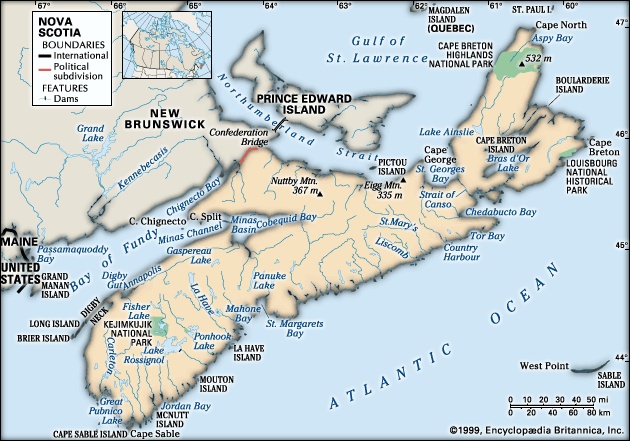
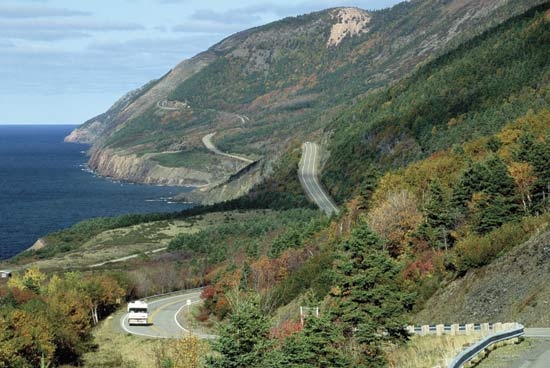 Nova Scotia's upland regions reach a maximum elevation of more than 1,700 feet (520 metres) above sea level in the Cape Breton Highlands. The most important lowlands lie along the Bay of Fundy and the Minas Basin in the southwest and along the Northumberland Strait. Many of the tens of thousands of acres of marshland created by the tremendously high tides—among the highest in the world—of the Bay of Fundy have been turned to agricultural use by dikes, which were begun in the mid-17th century by the early French settlers, the Acadians.
Nova Scotia's upland regions reach a maximum elevation of more than 1,700 feet (520 metres) above sea level in the Cape Breton Highlands. The most important lowlands lie along the Bay of Fundy and the Minas Basin in the southwest and along the Northumberland Strait. Many of the tens of thousands of acres of marshland created by the tremendously high tides—among the highest in the world—of the Bay of Fundy have been turned to agricultural use by dikes, which were begun in the mid-17th century by the early French settlers, the Acadians.More than 3,000 lakes and hundreds of short rivers and streams either have been impounded by or have cut through the irregularly high and low landscapes. The best-known of the lakes, Bras d'Or (Bras d'Or Lake) on Cape Breton Island, is saline, connected to the Atlantic Ocean through three short channels. Many intruding heads of land make the lake's 424 square miles (1,098 square km) a geographic complexity.
Nearly nine-tenths of Nova Scotia's landmass is unsuitable for agriculture. Most of the southern peninsula rests upon acidic granite, and a large part of Cape Breton Island is mountainous, forested terrain of acidic and metamorphic rock. Podzolic soil dominates, with some gray wooded soil mainly along the Northumberland Strait. In a few pockets where clastic sedimentary rock, mostly sandstone, underlies the soil—as in the Annapolis Valley, along parts of the Northumberland Strait, and at Cobequid Bay—the land supports orchards and field crops. In 2008 the Joggins Fossil Cliffs, which hold numerous fossils from the Carboniferous Period, were designated a UNESCO World Heritage site.
Climate
Nova Scotia has a modified continental climate that is greatly influenced by the proximity of the sea. The Atlantic coastal regions experience the warmest winter and coolest summer temperatures. At Halifax, on the central part of the Atlantic coast, the average daily temperature in January is about 24 °F (–4.5 °C), while in July the average daily temperature is nearly 66 °F (19 °C). Winters in the inland areas are generally colder, with the coldest temperatures occurring in the highlands, and summers are slightly warmer. Yearly precipitation (both rain and snow) varies considerably, depending on the section of the province, with total annual amounts ranging from less than 49 inches (1,250 mm) along the Northumberland Strait to more than 63 inches (1,600 mm) on the Cape Breton Highlands plateau.
Plant and animal life
Forests occupy about four-fifths of the land area. About one-quarter of the woodland is held as crown, or public, land. Softwoods are by far the most numerous, led by species of balsam, spruce, hemlock, and pine; birch and maple make up most of the hardwoods. Animal life includes such game species as deer and moose and, among the birds, partridge, pheasant, and duck.
People
Population composition
The Mi'kmaq people had occupied the area for centuries before the arrival of the first Europeans in the late 15th century. Primarily hunters and gatherers, the Mi'kmaq ranged over the Maritime Provinces and into the Gaspé Peninsula and later spread to Newfoundland and New England. Their Algonquian language (Algonquian languages) is reflected in such Nova Scotian place-names as Musquodoboit, Pugwash, and Shubenacadie. Many of Nova Scotia's Mi'kmaq people now live on reservations.
About one-eighth of Nova Scotia's population is at least partially descended from the Acadian French, some of whom returned from exile after the end of French-English conflict in North America in 1763. Acadian communities, with a lively Acadian culture, are located in southwestern Nova Scotia and on Cape Breton Island.
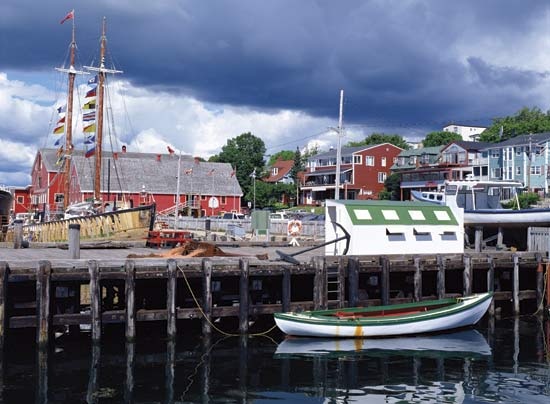 Most of the remaining people are descended from settlers from the British Isles and from what is now the United States. In the second half of the 18th century, settlers from New England (known as Planters) and, later, American colonists loyal to Great Britain during the American Revolution (known as United Empire Loyalists) settled much of western and northern Nova Scotia, with scattered settlements elsewhere. Settlers from England (Yorkshire) and Scotland populated northern and eastern Nova Scotia; the Scots, who settled in substantial numbers in Cape Breton, gave the province a strong Gaelic culture. Irish migration, especially in the 19th century, greatly expanded the population of the Halifax region, among others. German immigrants in the 1750s founded the seaport of Lunenburg.
Most of the remaining people are descended from settlers from the British Isles and from what is now the United States. In the second half of the 18th century, settlers from New England (known as Planters) and, later, American colonists loyal to Great Britain during the American Revolution (known as United Empire Loyalists) settled much of western and northern Nova Scotia, with scattered settlements elsewhere. Settlers from England (Yorkshire) and Scotland populated northern and eastern Nova Scotia; the Scots, who settled in substantial numbers in Cape Breton, gave the province a strong Gaelic culture. Irish migration, especially in the 19th century, greatly expanded the population of the Halifax region, among others. German immigrants in the 1750s founded the seaport of Lunenburg.Beginning in the 20th century, there were smaller migrations of Dutch, Italian, Polish, Arab, Chinese, South Asian, and other peoples, especially to the urban centres of Halifax and Sydney. The small black population in the province includes the descendants of slaves brought into the colony in the 18th century as well as the descendants of black loyalists; West Indian immigrants have bolstered the black population.
English is the only spoken language of the vast majority of the people. Nova Scotians who speak only French are few. However, both Gaelic and the native language of the Mi'kmaq have experienced a renaissance in recent years. Approximately one-third of Nova Scotians are Roman Catholics; among the Protestant denominations, the United Church of Canada is the largest, followed by the Anglican and Baptist churches.
Settlement patterns and demographic trends
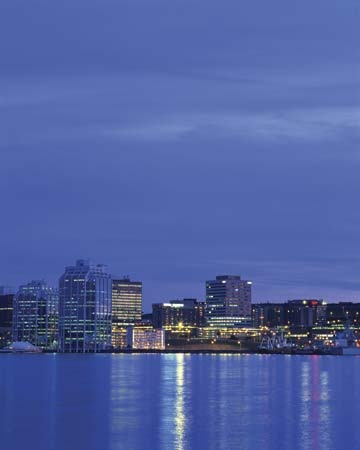 Urbanization was an important trend during the 20th century, but nearly one-half of Nova Scotians still live outside major population centres. The early European settlement tended to hug the coastline; the sea provided the main means of transportation, and the economy was based on fisheries, the fur trade, and farming. Yet even with the development of railways and better roads in the 19th and 20th centuries, the interior of the province has remained sparsely settled. With the decline in the late 19th century of shipbuilding and shipping, the coal, steel, and textile industries drew workers to the major centres of Sydney and Halifax, while such smaller towns as Yarmouth, Windsor, Truro, and Amherst developed smaller-scale manufacturing and processing industries. The last century and a half has seen a major out-migration of Nova Scotians, first to New England and later to Ontario and the Canadian West.
Urbanization was an important trend during the 20th century, but nearly one-half of Nova Scotians still live outside major population centres. The early European settlement tended to hug the coastline; the sea provided the main means of transportation, and the economy was based on fisheries, the fur trade, and farming. Yet even with the development of railways and better roads in the 19th and 20th centuries, the interior of the province has remained sparsely settled. With the decline in the late 19th century of shipbuilding and shipping, the coal, steel, and textile industries drew workers to the major centres of Sydney and Halifax, while such smaller towns as Yarmouth, Windsor, Truro, and Amherst developed smaller-scale manufacturing and processing industries. The last century and a half has seen a major out-migration of Nova Scotians, first to New England and later to Ontario and the Canadian West.Economy
Nova Scotia has a diversified economy based on both land and sea resources. Traditional industries such as fishing, forestry, and mining are in decline, while tourism and other service industries are becoming much more significant components of the economy.
Agriculture, forestry, and fishing
Farming has tended to focus on dairy products, livestock, poultry and eggs, and fruit. Extensive forestry resources supply large pulp and paper mills, numerous sawmills, and the expanding Christmas tree and maple syrup industries.
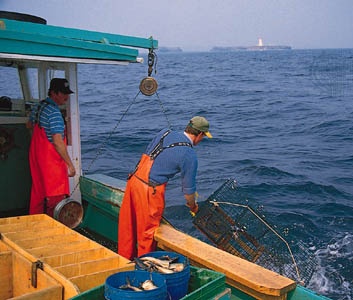 The catching, processing, and exporting of fish continue as important but declining industries. The near-complete destruction of cod stocks has decimated this traditional component of the fisheries. However, lobster, scallops, and other shellfish, along with haddock and herring, remain important catches in Nova Scotian waters. Aquaculture is an increasingly significant facet of the fishing industry.
The catching, processing, and exporting of fish continue as important but declining industries. The near-complete destruction of cod stocks has decimated this traditional component of the fisheries. However, lobster, scallops, and other shellfish, along with haddock and herring, remain important catches in Nova Scotian waters. Aquaculture is an increasingly significant facet of the fishing industry.Resources and power
Mining is another major industry in Nova Scotia. Traditionally, coal was the leading mined product, but many coal mines closed in the late 20th and early 21st centuries. Salt and anhydrite production meet a wide demand, and the provincial gypsum deposits yield about three-fourths of Canada's supply. There are significant resources of barite and construction materials, such as sand and gravel. The continent's first tidal energy project, completed in 1984 near Annapolis Royal, harnesses the tides of the Bay of Fundy to enhance the province's hydroelectric energy output. Natural gas is pumped from wells located off Sable Island and carried to the mainland via pipeline.
Manufacturing, services, labour, and taxation
Food processing, wood- and paper-related industries, metal production, and many smaller industries provide a solid manufacturing base to the provincial economy. However, most of the labour force is employed in public and private services. Tourism is a particularly strong service industry, with more than a million people visiting the province each year. More than one-fourth of provincial workers are employed in knowledge-based service industries, such as telecommunications, computer technology, and education. In fact, more Nova Scotians work as teachers and university professors than as fish-processing, forestry, and construction workers combined. Also significant for the economy are several Canadian Forces military bases located within the province.
Provincial income is derived from two main sources: various provincial taxes and fees and the federal government. Important taxes levied by the province include personal and corporate income taxes, a sales tax, and a fuel tax.
Transportation and telecommunications
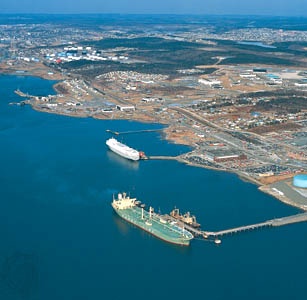 Shipping remains a major enterprise in Nova Scotia. Point Tupper accommodates the world's largest oil carriers, and Halifax, a railroad terminus and year-round ice-free port, has facilities for all types of vessels, including huge container ships. Other transportation needs are served by a network of paved highways, by a trucking industry that has largely displaced local rail service, and by an international airport at Halifax and several smaller airports. Car and passenger ferries operate between Nova Scotia and ports in New Brunswick, Prince Edward Island, Newfoundland and Labrador, and the U.S. state of Maine.
Shipping remains a major enterprise in Nova Scotia. Point Tupper accommodates the world's largest oil carriers, and Halifax, a railroad terminus and year-round ice-free port, has facilities for all types of vessels, including huge container ships. Other transportation needs are served by a network of paved highways, by a trucking industry that has largely displaced local rail service, and by an international airport at Halifax and several smaller airports. Car and passenger ferries operate between Nova Scotia and ports in New Brunswick, Prince Edward Island, Newfoundland and Labrador, and the U.S. state of Maine.Nova Scotia has a highly developed, fully digital telecommunications system that features a provincewide fibre-optic network. Cellular telephone service and high-speed Internet access are widely available.
Government and society
Constitutional framework
Nova Scotia's governmental structure is similar to that of all Canadian provinces. A lieutenant governor appointed by the federal government serves as representative of the crown and titular head of state. The premier, who is the leader of the party in power in the provincial assembly, selects a cabinet from among the elected party. While judges of the province's higher courts are federally appointed, the provincial government appoints judges to lower courts; judges normally serve until retirement. Government employees are recruited through a nonpolitical civil service.
Since Canadian confederation there have been two major political parties in Nova Scotia: the Liberals (Liberal Party of Canada) and the Conservatives (later known as the Progressive Conservatives (Progressive Conservative Party of Canada)). The New Democratic Party experienced dramatic growth in the late 20th century.
Health and welfare
In 1969 Nova Scotia joined the federal medical care program. The premium is paid from the province's general revenues, and insured services include all medically necessary procedures and care. The province provides facilities for mental health, dental care, tuberculosis control, and other public health services. Nova Scotia's welfare services, similar to those in other provinces, cover old-age assistance, allowances for the blind and disabled, social assistance, social development, child welfare and adoptions, and services for single parents.
Education
The nondenominational system of compulsory, free public education, dating from the mid-19th century, provides Nova Scotians with high-quality education from kindergarten through grade 12. In areas of the province where demand is sufficient, education is available in French as part of the publicly funded school system. Higher education is offered by a system of technical schools and community colleges, as well as by the largest number of universities per capita of any province in Canada. Dalhousie University in Halifax is the largest; it offers a variety of programs, including law, medicine, nursing, and dentistry. Sainte-Anne University is Nova Scotia's only French-language university. St. Francis Xavier University, in Antigonish, has attracted international interest in its adult-education programs, while Acadia University, in Wolfville, has become a leader in Canada in the use of technology in learning. With many programs designed specifically for women, Mount Saint Vincent University, in Halifax, is the only university in Canada to make the education of women its focus.
Cultural life
The cultural life of Nova Scotia is rich and varied, reflecting both the cultural diversity of its people and the strong sense of its past. Traditional aspects of Scottish and Acadian culture are particularly vibrant. A number of provincial organizations do much to encourage cultural and artistic development.
 In the last decades of the 20th century a major revival of interest in Celtic music began, with singers and musicians (especially fiddlers) from Cape Breton becoming well known nationally and internationally. St. Francis Xavier University offers courses in Celtic studies, and the Gaelic College in St. Ann's, Cape Breton, teaches Celtic piping, singing, dancing, and handicrafts. Clan gatherings take place annually at St. Ann's to celebrate the Gaelic Mod, a festival of Highland folk arts.
In the last decades of the 20th century a major revival of interest in Celtic music began, with singers and musicians (especially fiddlers) from Cape Breton becoming well known nationally and internationally. St. Francis Xavier University offers courses in Celtic studies, and the Gaelic College in St. Ann's, Cape Breton, teaches Celtic piping, singing, dancing, and handicrafts. Clan gatherings take place annually at St. Ann's to celebrate the Gaelic Mod, a festival of Highland folk arts.Acadian culture, fostered by a French-language school system, French-language radio and television stations, and local festivals, remains an important part of the life of the province. The late 20th century witnessed a renewed interest in the culture and traditions of the Mi'kmaq. Nova Scotia's black community has retained a strong sense of its own traditions as well.
Major cultural institutions include the Neptune Theatre and the Art Gallery of Nova Scotia, both in Halifax, and the Nova Scotia Museum system. Live theatre flourishes in many centres in the province, especially during the summer months. Artists and writers have found the province both a congenial place in which to live and a stimulating climate in which to work.
 Several impressive historic sites belonging to Canada's national parks system reflect the rich history of the region. These include a reconstruction of the 1605 French habitation at Port Royal, the reconstructed fortress of Louisbourg, the Halifax Citadel, the Alexander Graham Bell National Historic Site at Baddeck (where the Scottish-born American inventor Alexander Graham Bell (Bell, Alexander Graham) had a summer home), and the Grand-Pré National Historic Site in the Annapolis Valley (a centre of Acadian settlement and deportation in the 18th century). Another significant historic site is Old Town Lunenburg, which was declared a UNESCO World Heritage site in 1995. In addition, there are a number of provincial museums, and most communities have museums reflective of local history.
Several impressive historic sites belonging to Canada's national parks system reflect the rich history of the region. These include a reconstruction of the 1605 French habitation at Port Royal, the reconstructed fortress of Louisbourg, the Halifax Citadel, the Alexander Graham Bell National Historic Site at Baddeck (where the Scottish-born American inventor Alexander Graham Bell (Bell, Alexander Graham) had a summer home), and the Grand-Pré National Historic Site in the Annapolis Valley (a centre of Acadian settlement and deportation in the 18th century). Another significant historic site is Old Town Lunenburg, which was declared a UNESCO World Heritage site in 1995. In addition, there are a number of provincial museums, and most communities have museums reflective of local history.Cape Breton Highlands National Park and Kejimkujik National Park provide popular scenic and wilderness experiences. There is also an extensive system of provincial parks. Popular sporting and recreational activities include football (soccer), golf, hockey, kayaking and canoeing, walking, and gardening.
There are a great many community newspapers and a number of local radio stations in the province. The region also is well served by the provincial newspaper The Chronicle Herald of Halifax as well as by radio and television affiliates of the Canadian Broadcasting Corporation (CBC) and Canadian Television (CTV) networks.
History
 After thousands of years of occupation by aboriginal peoples, the region came to the attention of Europeans, perhaps during the Viking voyages of c. AD 1000 and certainly by the late 15th century. The rich fisheries of the coast provided the major impetus for European involvement in the area. In the early 17th century, a group of French merchants led by Pierre du Gua, sieur de Monts, and assisted by the explorer Samuel de Champlain (Champlain, Samuel de), established trading posts in the region; one founded at Port Royal (near present-day Annapolis Royal) in 1605 was the first permanent European settlement in North America north of Florida. In 1621 the English king James I granted the area to a Scottish nobleman, Sir William Alexander. This led to a brief, unsuccessful Scottish settlement at Port Royal (1629–32).
After thousands of years of occupation by aboriginal peoples, the region came to the attention of Europeans, perhaps during the Viking voyages of c. AD 1000 and certainly by the late 15th century. The rich fisheries of the coast provided the major impetus for European involvement in the area. In the early 17th century, a group of French merchants led by Pierre du Gua, sieur de Monts, and assisted by the explorer Samuel de Champlain (Champlain, Samuel de), established trading posts in the region; one founded at Port Royal (near present-day Annapolis Royal) in 1605 was the first permanent European settlement in North America north of Florida. In 1621 the English king James I granted the area to a Scottish nobleman, Sir William Alexander. This led to a brief, unsuccessful Scottish settlement at Port Royal (1629–32).For the next century and a half, the region was a focal point for French-English rivalry for control of North America. This struggle for control retarded European settlement of the region and greatly altered the lives of the French settlers, or Acadians. The territory passed back and forth between France and England until 1713, when one of the treaties of Utrecht (Utrecht, treaties of) conveyed mainland Nova Scotia to the English for the last time, although conflict continued for another 50 years. The French retained Cape Breton Island, where they built the powerful fortress of Louisbourg, which the English attempted to counter by the founding in 1749 of Halifax as the new administrative and military centre of their colony. In the 1750s the English expelled the Acadians from the region—an event romanticized and popularized by the New England poet Henry Wadsworth Longfellow (Longfellow, Henry Wadsworth) in his narrative poem Evangeline.
Offers of free land attracted immigrants from the British Isles, the Germanic states, and New England; these newcomers gave the colony its first substantial Protestant population. By the time of the American Revolution, New Englanders constituted roughly two-thirds of Nova Scotia's population. In spite of some support for the revolution, the colony remained largely passive during the conflict, and approximately 35,000 loyalists (loyalist) immigrated to the province from the revolting colonies to the south. Meanwhile, Prince Edward Island had split off from Nova Scotia in 1769, and New Brunswick and Cape Breton followed in 1784; the last was reunited with Nova Scotia in 1820. In 1848 Nova Scotia became the first British colony in which the administration of government was responsible to the majority in the House of Assembly, the representative branch of colonial government. Despite opposition from some economic and political leaders, confederation with the colonies of New Brunswick and Canada (present-day Quebec and Ontario) was carried out in 1867.
As a separate British colony, Nova Scotia had prospered from its forestry, fisheries, and shipbuilding for the first two-thirds of the 19th century. Under the Reciprocity Treaty (1854) between the Canadian colonies and the United States, the north-south flow of commerce and Nova Scotia's normal market and supply source in New England seemed secure. The colony benefited further from the increased demand by both the North and the South of the United States during the American Civil War. However, the termination of reciprocity in 1866 and changing continental and world trade patterns eroded much of Nova Scotia's traditional economy. The linking of Nova Scotia with central Canada via the railway did not bring all the expected benefits to the region; rather, it helped to make the province more economically dependent on Quebec and Ontario. The late 19th century witnessed the extensive industrialization of parts of Nova Scotia, but in general the early 20th century saw the consolidation of financial and industrial power in Montreal and Toronto. The extensive out-migration of Nova Scotians, mainly to the New England states and western Canada, was a sign of the troubled economy.
During both of the 20th-century World Wars, Halifax played a key role in the transportation of men and supplies to Europe; the city experienced unprecedented prosperity as a result. During World War I, much of the city was destroyed when two ships collided in Halifax Harbour on Dec. 6, 1917. The collision resulted in the largest man-made explosion in history prior to the advent of the atomic bomb. More than 1,500 Haligonians were killed.
At the turn of the 21st century, Nova Scotia's population and economy continued to experience modest growth. The large potential of offshore gas reserves and an expanding technology-based industrial sector augured well for the future of the province, as did the tourism industry. However, increasing difficulties posed by border security and the high cost of gasoline led to a decline in the number of American tourists visiting the province.
Additional Reading
Robert J. McCalla, The Maritime Provinces Atlas (1988), provides information in a graphic format. The structure of provincial government is dealt with in J. Murray Beck, The Government of Nova Scotia (1957, reprinted 1973), and Politics of Nova Scotia, 2 vol. (1985–88). The history of the province is covered by Lesley Choyce, Nova Scotia: Shaped by the Sea: A Living History (1996); Phillip A. Buckner and John G. Reid (eds.), The Atlantic Region to Confederation: A History (1994); E.R. Forbes and D.A. Muise (eds.), The Atlantic Provinces in Confederation (1993); and Margaret R. Conrad and James K. Hiller, Atlantic Canada: A Region in the Making (2001). N.E.S. Griffiths, From Migrant to Acadian: A North American Border People, 1604–1755 (2004), deals with the early colonial period.
- Prix de l'Arc de Triomphe
- Prix de Rome
- Prix du Jockey Club
- Prix Fémina
- Prix Goncourt
- Prix Renaudot
- priyayi
- prize cases
- prize court
- Prizren
- Priština
- probabilism
- probability and statistics
- probability theory
- probate
- probation
- probenecid
- problem of evil
- problem of induction
- problem of other minds
- problem play
- Probolinggo
- proboscidean
- proboscis monkey
- Probus